The Pros and Cons to Adeptus Titanicus
By Ian
Painting my first Warlord Titan has once again given me the bug to be enveloped by the manifold and dive back into Titanicus. But maybe you haven’t taken the plunge yet. Maybe you’ve found the game intimidating or the price point of the models too high. Here’s my breakdown of the good and the bad of GW’s best skirmish game.
The Good
The models are fantastic
Without exception, the models for this game are phenomenal. All of them are extremely detailed, the kits come with many options, and each has room to lavish great attention to individual plates with freehand, battle damage, or transfers.
Blend of modern board game mechanics and classic crunch
In many ways, Titanicus does not feel like 40k. Instead of “I go, you go”, there’s alternating activations; instead of codicies, there are command terminal sheets and weapon cards to reference all your engines’ information and track their status. It’s a breath of fresh air compared to some of Games Workshop’s games which, though loveable, feel dated.
That being said, there are also classic mechanics. Your titans have facings and firing arcs. They can only turn up to 45 degrees at a time. You’ll roll on at least three different tables over the course of a game. There are templates and scatter dice. And don’t you dare pre-measure.
But it all works. The in-depth crunch of the rules is enjoyable, as you’re only tracking five or six models (ten at the most, unless you’re running a knight household), you can take some time to roll on a chart to see what your reactor is doing (spoiler alert: it’s overheating) or carefully line up your Warhound to get a shot on a Warlord’s flank.
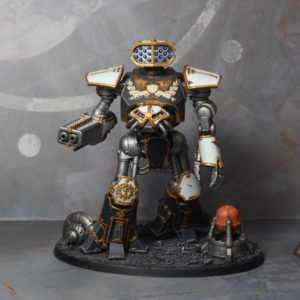
Surprisingly cheap to get started
Although the individual models are not cheap, as it requires so few of them, the game is quite affordable compared to 40k. The starter set gets you everything you need for a ~1,250 point force, and either the Loyalist Legio or Traitor Legio book will complement the core rulebook, giving you all the faction, maniples (think detachments from 8th or 9th Edition 40k), and stratagems you’ll ever need. From there, you can add two Warhounds, two Reavers or a Warlord–or a second starter set, if you really want lots of titans–and you’ll be at the 1,750 point mark (the standard game size).
Some of the hidden costs are the weapon cards: outside of the ones you’ll get in the starter set, you don’t get more cards with the Warhounds, Reaver, or Warlord kits. The Command Terminals for those titans are also sold separately, but you can download high resolution copies off Warhammer Community (for other titans, the Command Terminals are included). You also may want to pick up an extra weapon from Forgeworld, depending on how you want to build out your maniple and loadout your engines (the weapon cards for these will either come with the kit or will be in the card pack). With the new Legions Imperialis on the horizon, many Forgeworld weapon options may be going plastic too.
Finally, one of the potential pitfalls of Titanicus is that the scale of your terrain may be off. However, the epic-ness of the setting lends itself to larger-than-life scenery. Shipping crates, warehouses, statues: these all will fit on a Titanicus battlefield. The 31st and 41st millennium is full of massive structures. That being said, TTCombat’s Cityscape or Ruinscape card buildings for Dropzone Commander work as a great starter for Titanicus terrain, and are very affordable (though they may be difficult to find). One box can fill out about two or more 4’ x 4’ tables, not including any 40k terrain you may have on hand. There’s also lots of 3D printable and MDF options for Titanicus terrain.
Starter Set $210 CAD
Loyalist/Traitor Book $65 CAD
Additional titan(s) (with cards) $90-150 + $18 CAD (or second Starter Set $210 CAD)
FW weapon $24.50-45 CAD
TTCombat Dropzone Commander Cityscape/Ruinscape ~$50 CAD
Total $580 CAD MSRP (choosing the more expensive options)
Compare this to a 2,000 point Space Marine army in 10th Edition, assuming you already have terrain for 40k:
Leviathan Starter set, split with a friend $150 CAD
Heavy Intercessors $80 CAD
Assault Intercessors $75 CAD
Bladeguard Veterans x 2 $140 CAD
Hellblasters $75 CAD
Land Raider $110 CAD
Total $630 CAD MSRP (Is this a tournament list? I don’t know, you’re a tournament list.) I also did a non-Leviathan list that came out to $880 CAD MSRP, for whenever those boxes become extinct in the wild.
I’m not going to pretend $500+ is cheap, but it is cheaper than starting a new 40k army, and it may be cheaper than you thought. The Starter Set also gives you everything you need to start playing and is the perfect entry point to dip your toe in. Again, a $210 starter set isn’t exactly an impulse buy, but it is excellent value.
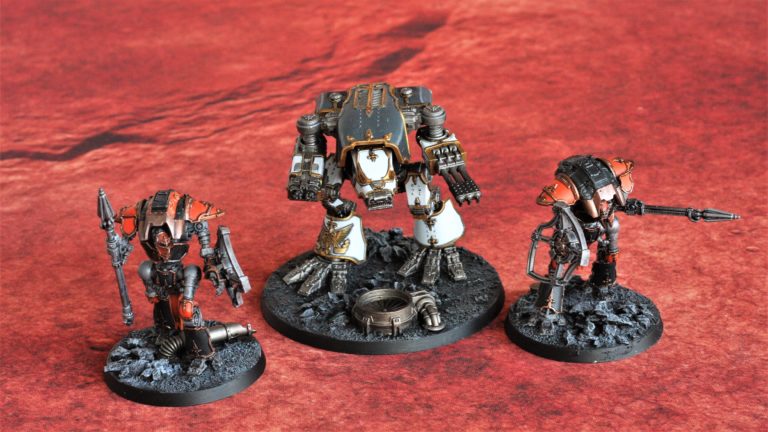
Condensed ruleset
Before the Loyalist Legio book, the rules for Titanicus were spread over multiple campaign books. Each had a smattering of Legio traits, stratagems, and maniples, plus lore, narrative missions, and, in some cases, rules for new titans. You would potentially need multiple books just to run your preferred maniple and Legio.
Not anymore. The Loyalist Legio book gathered and updated all the rules a loyalist force would need and the Traitor Legio book followed suit. One of these and the core rules will last you a long time until you’re ready to start a campaign or run a tournament: then you can pick up the other books at your leisure without feeling handicapped because you’re missing out on rules.
Finally, as there are less frequent updates, you don’t have the breakneck pace of evolving rules you find in Games Workshop’s flagship games. If you’re like me and don’t enjoy a constantly shifting landscape of errata, FAQs and seasons, you’ll sit, stay awhile, and appreciate the game.
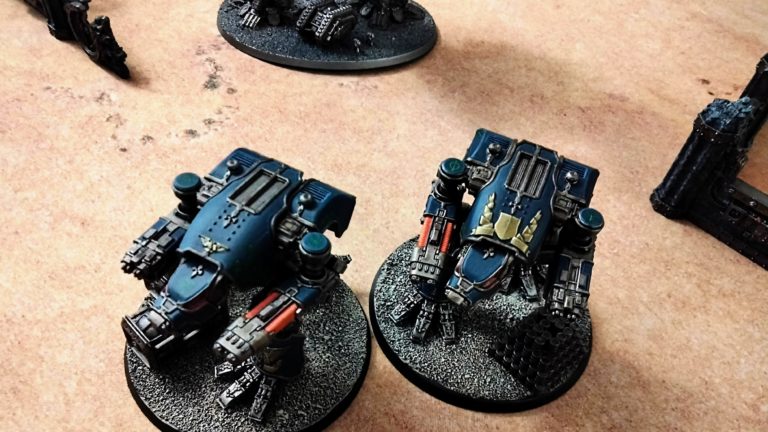
Awesome lingo
If you’ve read any of the Horus Heresy books that feature titans, you’ll know there’s a wide breadth of cool jargon relating to Titanicus. Titans are “Engines”, their Commanders “Princeps”, their Crew “Moderati”. The interface between Princeps and the Engines is the “Manifold”.
This all adds up to a well-developed background for the titan legions (“legios”) which builds the immersion for the game. Combined with many of the rules, this creates a deeply narrative experience for the players–and one that lends itself well to shouting “Engine kill!” whenever you down a titan.
The Bad
Models are complex
Though the models are amazing hobby projects, they are time consuming to build and paint. Even for experienced hobbyists, it’s important to carefully follow the instructions, as similar armour panels can be easily mixed up or limbs glued on reversed. To get the most out of the kits, you’ll need to magnetise each weapon mount: some of these already have a slot for magnets, but some joints require cutting.
I’ve painted all my titans in subassemblies, something I rarely do for other kits, and even the instructions suggest which parts should be assembled separately. These kits are rewarding to build and paint, but are not for a beginner hobbyist.
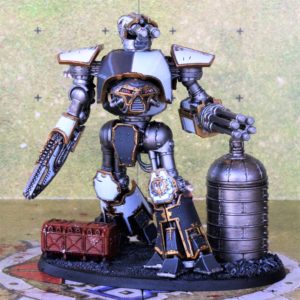
Small community
Likely the biggest hurdle to playing this game is the lack of community. When I started writing this article, I knew exactly one other person who played. Fortunately, running demo games with the starter set (plus any other titans you have) plays well and gives a good feeling for the mechanics. As mentioned above, the rules are quite intuitive, so anyone who’s played 40k for a while (especially if they’ve played before 8th edition or Necromunda) will likely pick it up quickly. (When we published this article, I knew three other players who got into the game after a single demo, so it is catching!)
Limited factions
Titanicus is set during the Horus Heresy and the only faction is Imperial. Of course these are split between Loyalist and Traitor (and Blackshield), and you can also be a special snowflake by playing a knight household, but at the end of the day every player is drawing their force from the same pool of models. Outside of 3D printed, counts-as models and house rules, there are no xenos factions. Hopefully this will be expanded in the future, but there’s currently no indication we’ll ever see Ork Gargants or Eldar Phantoms walking.
Few updates
Titanicus is from the specialist game studios and only receives a few updates a year, whether this is new books or models (sometimes just a new weapon set). Though above I mentioned this can be nice as you’re not inundated with ever-changing rules to track, it can sometimes feel like you’re playing a dying game or that it’s been forgotten.
But what about Legions Imperialis (aka new Epic)?
GW has already confirmed that there will be continued support for Titanicus and Imperialis are going to be a very different game. So if you like titans and want to play a skirmish-sized robot game with hyper immersive rules, play Titanicus. If you want to field literally hundreds of troops without each turn taking a week, Imperialis is probably going to be your best bet. For me, I love Titanicus just the way it is and Imperialis won’t replace it (though I may end up starting a tiny, wittle Blood Angels battalion).
At the time of writing, we’ve seen a few previews for some new titan weapons and Forgeworld kits moving to plastic. I’d wager we’ll see a few more previews or releases by the end of the year with similar updates, so buyer beware that there may be reboxing with more options in the near future. That being said, you can always magnetize your weapons and add to them in the future.
Personally, I already have a fully magnetized maniple, so I’m holding off on adding to my Legio until I see the new boxes for Imperialis. But the current starter set is an amazing value with lots of options and is still great for new players.
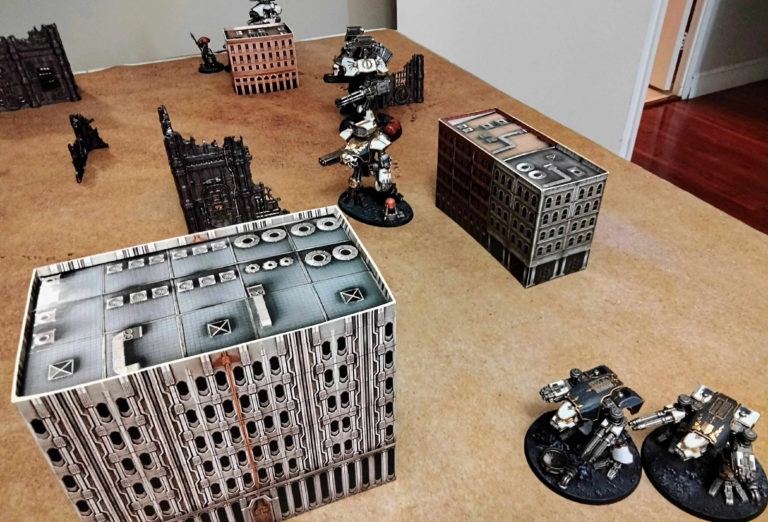
Conclusions
Adeptus Titanicus is hands down my favourite specialist or skirmish game that GW produces, second only to 40k as my favourite game. It is one of the most narrative, modern rules that have been produced by the company, with amazing models to back it up.
I’m by no means an expert in Titanicus (hence why I’ve provided a list of resources below for further reading/listening), but it’s a game that is always on my radar and one that I’m desperate to convince more people to play. Hopefully in the future we’ll be providing more Titanicus coverage, including ideas for linking it to games of 40k or Heresy. Until then, I look forward to seeing more engines walk.
Further reading and listening
The Independent Characters, Episode 189 – Adeptus Titanicus: Rise of the God Machines https://open.spotify.com/episode/0UkcHFrN1zQKajbgv9l7AE?si=75dcbeb0ae8b4f61
The ICs’ coverage of Titanicus is excellent: they do a great overview of the game and have a fantastic interview with one of the original game designers.
Goonhammer’s Adeptus Titanicus articles https://www.goonhammer.com/adeptus-titanicus/
If I’ve piqued your interest, Goonhammer has exhaustive guides on how to play, in depth coverage of the various Legios, and lots of great articles on all things Titanicus.
Maximal Fire – An Adeptus Titanicus Podcast for Princeps https://open.spotify.com/show/4g89KrjnSylbgGbkkluPpT?si=0dcdb28e60df40dc
Maximal Fire is a solid podcast dedicated to Titanicus hosted by gamers who play it as their primary game. There are a few dedicated Titanicus podcasts, but this one’s my favourite.
Lost to the Nails Podcast, Episode 6 – Adeptus Titanicus https://open.spotify.com/episode/5AMmZi1d46hRn7072HqlaB?si=3a2df27ff6db4a0f
This podcast actually has one of the same guests as the ICs’ episode above, and covers some of the same ground, but is more recent and also excellent listening.
Black Library novels featuring or focusing on titans: Titandeath by Guy Haley, Titanicus by Dan Abnett, Betrayer by Aaron Dembski-Bowden, Mortis by John French, Mechanicum by Graham McNeill (and probably others)